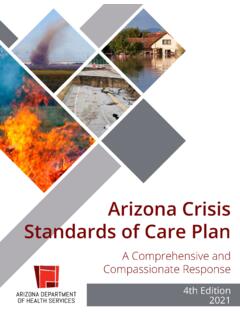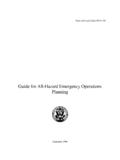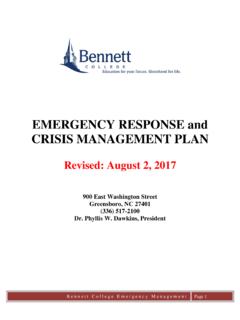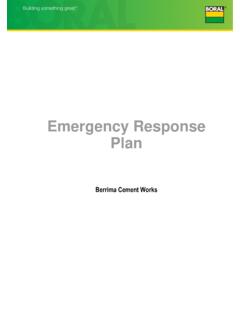Transcription of EMERGENCY ACTION PLAN FOR ATHLETICS - St. Paul's School
1 1 EMERGENCY ACTION plan FOR ATHLETICS Prepared By: Christian M. Stipe, ATC, LAT St. Paul s School 917 S. Jahncke Ave. Covington, LA 70433 Updated September 27, 2017 2 ST. PAUL S School EMERGENCY ACTION plan FOR ATHLETICS Table of Contents OVERVIEW OF THE EMERGENCY ACTION plan 4 POLICIES AND PROCEDURES 8 Reporting Injuries 9 Over the Counter Medications 9 Physician Referrals 9 Getting Hurt on the Field 9 Other Injury Management 9 Travel Kits for Coaches 9 BASIC INJURY MANAGEMENT FOR SPORT COACHES 10 Bone Injuries 11 Concussions 12 Environmental Concerns 13 Equipment Concerns 14 Hydrating Athletes 15 Skin Disorders 16 Special Concerns 17 Sprains & Strains 18 Supplements 19 Wound Care 20 BASIC TAPING TECHNIQUES FOR SPORT COACHES 21 Ankles 22 Elbow 23 Foot Arch 24 Groin 25 Heel 26 Thumb 27 Wrist 28 DEALING WITH SPORT EMERGENCIES AT ST.
2 PAUL S School 29 Heap Field (Baseball) 30-31 New Gymnasium (Basketball & Wrestling) 32-33 Hunter Stadium (Football, Soccer, Track, Cross Country & Lacrosse) 34-35 Old Gymnasium (Wrestling) 36-37 Upper Varsity Field (Soccer & Football) 38-39 Lower Practice Field (Soccer and Football) 40-41 3 ST. PAUL S School PROTOCOLS, POLICIES & PROCEDURES 42 EMERGENCY Contacts 43 Heat Safety Protocol 44-46 Lightning Safety Protocol 47-48 Helmet Removal Protocol 49-50 AED Protocol 51-55 Concussion Protocol 56 Concussion Evaluation Packet 57-62 Notification of Injury Form 63 Football Camp EAP at Nicholls State University 64-66 Blood Borne Pathogens Protocol 67-68 4 ST. PAUL S School EMERGENCY ACTION plan FOR ATHLETICS OVERVIEW Introduction EMERGENCY situations may arise at anytime during athletic events.
3 Expedient ACTION must be taken in order to provide the best possible care to the sport participant of EMERGENCY and/or life threatening conditions. The development and implementation of an EMERGENCY ACTION plan will help ensure that the best care will be provided. As emergencies may occur at anytime and during any activity, all School activities workers must be prepared. Athletic organizations have a duty to develop an EMERGENCY ACTION plan that may be implemented immediately when necessary and to provide appropriate standards of EMERGENCY care to all sports participants. As athletic injuries may occur at any time and during any activity, the sports medicine team must be prepared. This preparation involves formulation of an EMERGENCY ACTION plan , proper coverage of events, maintenance of appropriate EMERGENCY equipment and supplies, utilization of appropriate EMERGENCY medical personnel, and continuing education in the area of EMERGENCY medicine and planning.
4 Hopefully, through careful pre-participation physical screenings, adequate medical coverage, safe practice and training techniques and other safety avenues, some potential emergencies may be averted. However, accidents and injuries are inherent with sports participation, and proper preparation on the part of the sports medicine team should enable each EMERGENCY situation to be managed appropriately. Components of the EMERGENCY ACTION plan These are the basic components of every EMERGENCY ACTION plan for ATHLETICS : 1. EMERGENCY Personnel 2. EMERGENCY Communication 3. EMERGENCY Equipment 4. Roles of Certified Coaches and Administrators 5. Venue Directions with Map The St. Paul s School EMERGENCY ACTION plan also includes the following: Basic Injury Management for Coaches Basic Taping Techniques for Coaches EMERGENCY plan Personnel With athletic practice and competition, the first responder to an EMERGENCY situation is typically a coach.
5 The type and degree of sports medicine coverage for an athletic event may vary widely, based on such factors as the sport or activity, the setting, and the type of training or competition. Certification in cardiopulmonary resuscitation (CPR), first aid, prevention of disease transmission, and EMERGENCY ACTION plan review is required by St. Paul s School for all ATHLETICS personnel associated with practices, competitions, skills instruction, and strength and conditioning. The development of an EMERGENCY ACTION plan cannot be complete without the formation of an EMERGENCY team. The EMERGENCY team may consist of a number of healthcare providers including physicians, EMERGENCY medical technicians, coaches, parents, and, possibly, other bystanders. Roles of these individuals within the EMERGENCY team may vary depending on various factors such as the number of members of the team, the athletic venue itself.
6 There are four basic roles within the EMERGENCY team. The first and most important role is establishing safety of the scene and immediate care of the athlete. Acute 5 care in an EMERGENCY situation should be provided by the most qualified individual on the scene. In most instances, this role will be assumed by the Certified Athletic Trainer, although if the team physician is present, he/she may be called in. The second role, EMS activation, may be necessary in situations where EMERGENCY transportation is not already present at the sporting event. This should be done as soon as the situation is deemed an EMERGENCY or a life-threatening event. Time is the most critical factor under EMERGENCY conditions. Activating the EMS system may be done by anyone on the team. However, the person chosen for this duty should be someone who is calm under pressure and who communicates well over the telephone.
7 This person should also be familiar with the location and address of the sporting event. Typically, the School administrator is the best choice to fulfill this role. The third role, equipment retrieval may be done by anyone on the EMERGENCY team who is familiar with the types and location of the specific equipment needed. Student athletic trainers and coaches are good choices for this role. The fourth role of the EMERGENCY team is that of directing EMS to the scene. One member of the team should be responsible for meeting EMERGENCY medical personnel as they arrive at the site of the EMERGENCY . Depending on ease of access, this person should have keys to any locked gates or doors that may slow the arrival of medical personnel. A student athletic trainer, administrator, or coach may be appropriate for this role.
8 Roles within the EMERGENCY Team 1. Establish scene safety and immediate care of the athlete 2. Activation of the EMERGENCY medical System 3. EMERGENCY equipment retrieval 4. Direction of EMS to scene Activating the EMS System Making the Call: 911 (all emergencies in Idaho and Utah) Providing Information: name, address, telephone number of caller nature of EMERGENCY , whether medical or non- medical * number of athletes condition of athlete(s) first aid treatment initiated by ATC/Physician specific directions as needed to locate the EMERGENCY scene ( "Come to the faculty parking lot on Elm St. ) other information as requested by dispatcher When forming the EMERGENCY team, it is important to adapt the team to each situation or sport. It may also be advantageous to have more than one individual assigned to each role.
9 This allows the EMERGENCY team to function even though certain members may not always be present. EMERGENCY Communication Communication is the key to quick EMERGENCY response . Athletic trainers and EMERGENCY medical personnel must work together to provide the best EMERGENCY response capability and should have contact information established as a part of pre-planning for EMERGENCY situations. Communication prior to the event is a good way to establish boundaries and to build rapport between both groups of professionals. If EMERGENCY medical transportation is not available on site during a particular sporting event, then direct communication with the EMERGENCY medical system at the time of injury or illness is necessary. 6 Access to a working telephone or other telecommunications device, whether fixed or mobile, should be assured.
10 The communications system should be checked prior to each practice or competition to ensure proper working order. A back-up communication plan should be in effect should there be failure of the primary communication system. The most common method of communication is a cellular telephone, which is preferred if available. At any athletic venue, whether home or away, it is important to know the location of a workable telephone. Pre-arranged access to the phone should be established if it is not easily accessible. EMERGENCY Equipment All necessary EMERGENCY equipment should be at the site and quickly accessible. Personnel should be familiar with the function and operation of each type of EMERGENCY equipment. Equipment should be in good operating condition, and personnel must be trained in advance to use it properly.






